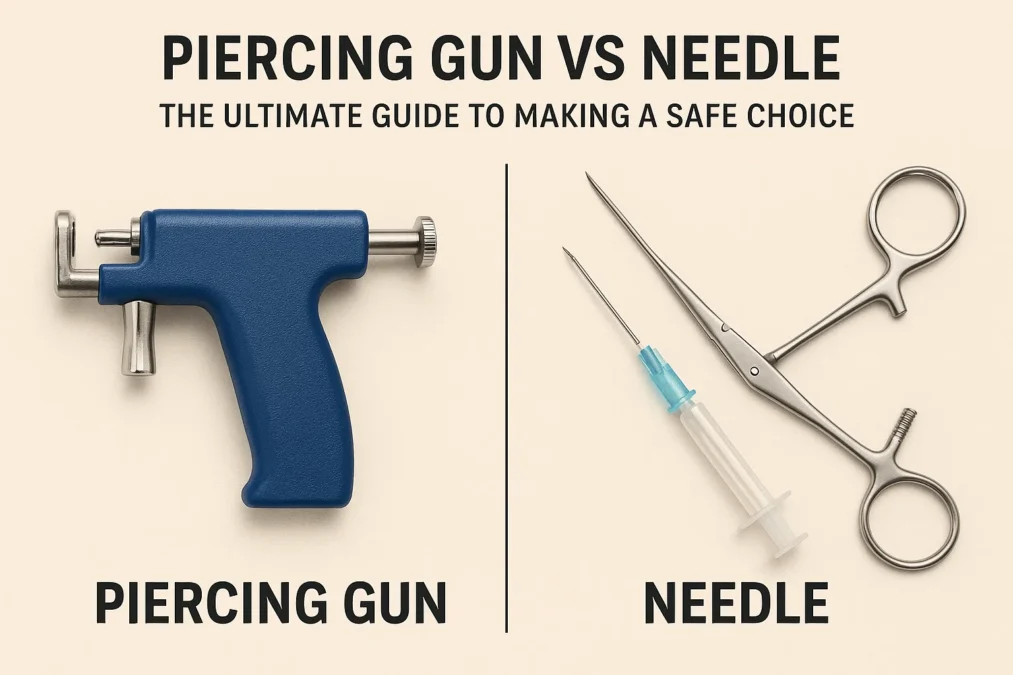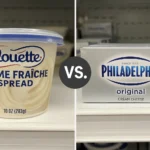So, you’re thinking about getting a new piercing. That’s exciting! Whether it’s your first lobe piercing or an addition to your curated ear, the journey is a personal form of expression. But before you get swept up in choosing the perfect jewelry, there’s a far more critical decision to make: where and how you get it done. This choice almost always boils down to one fundamental debate: the piercing gun vs the needle. This isn’t just a matter of preference; it’s a decision that impacts your safety, your comfort, and the long-term health of your piercing. Many people, especially those getting their ears pierced for the first time, might not even be aware there’s a difference. They walk into a mall kiosk, see a shiny, seemingly efficient tool, and assume it’s the standard. However, within the professional body modification community, the use of piercing guns is heavily discouraged, and for a compelling array of reasons. This comprehensive guide will walk you through every aspect of the piercing gun versus needle discussion. We’ll delve into the mechanics, the safety protocols, the healing process, and the professional standards that separate these two methods worlds apart. Our goal is to equip you with the knowledge you need to make an informed, safe choice for your body.
Understanding the Tools: How They Actually Work
To truly grasp the piercing gun vs needle debate, you first need to understand the fundamental mechanics of each tool. They don’t just differ in appearance; they function in completely opposing ways, and this basic operation is the root of almost every subsequent difference.
A piercing gun is a spring-loaded handheld device designed for speed and simplicity. The operator places a stud-style earring into the gun, positions the gun over the intended piercing location, and pulls a trigger. This action forces a sharp, pointed end of the stud through the tissue using a sudden, high-impact burst of pressure. The earring itself acts as the needle, and it is typically made of surgical steel or sometimes a lower-quality metal with a high nickel content. The process is over in a second, and the client walks away with their jewelry already in place. This method was developed for mass-market, retail environments where throughput is high and specialized training is minimal. The focus is on accessibility, not necessarily on the biology of wound creation.
In stark contrast, a hollow needle is a surgical-grade instrument used by professional piercers. The needle is extremely sharp, hollowed out like a tiny cannula, and comes individually sterilized in a sealed package. The piercer will mark the precise placement with a surgical pen, ensuring it’s exactly what you want and that it’s symmetrical. They then use the needle to manually create the piercing channel. The hollow core is the key here. As the needle punctures the skin, it cleanly removes a small core of tissue, much like a miniature cookie cutter, creating a clean, open hole exactly the size of the needle’s gauge. This allows for the jewelry, which is a separate, often smoother piece, to be inserted gently into the newly created space. This method is deliberate, controlled, and based on fundamental principles of surgery and wound care.
The Critical Difference in Technique and Tissue Damage
The mechanical difference between a gun’s blunt force trauma and a needle’s precise incision leads to a dramatic difference in the type of tissue damage they cause. This is the single most important factor in the piercing gun vs needle discussion from a biological perspective.
When a piercing gun fires, it rams a relatively blunt earring post through your skin. Skin is elastic and designed to resist tearing, so this sudden pressure doesn’t create a clean cut. Instead, it forces the tissue apart, causing a shockwave of trauma and bruising to the surrounding area. This is known as blunt force trauma. Think of it like pushing a dull thumbtack through a piece of leather versus using a sharp hole-punch. The thumbtack will tear and shred the fibers, leaving a ragged, damaged hole, while the hole-punch creates a clean, circular removal. This tearing effect is why gun piercings often hurt significantly more during the healing process, swell excessively, and are prone to developing hypertrophic scars or keloids. The body recognizes this damage as a severe injury and responds with an intense inflammatory response.
A hollow needle, by design, minimizes tissue damage. Because it is razor-sharp and removes a tiny plug of flesh, it creates a clean, precise wound. The surrounding tissue is left relatively undisturbed, with minimal crushing or bruising. This clean incision is recognized by the body as a more manageable injury, leading to a less aggressive inflammatory response. The result is a piercing that typically experiences less initial swelling, less prolonged pain, and a significantly reduced risk of developing scar tissue. The hollow needle technique respects the biology of the skin, creating a channel that the body can heal around more efficiently and with fewer complications. The difference in healing experience between the two methods is often night and day, all stemming from this initial moment of impact.
Sterilization and Hygiene: A Matter of Life and Bloodborne Pathogens
In any procedure that breaks the skin, sterilization isn’t just a best practice; it’s a non-negotiable requirement for preventing serious infections, including bloodborne pathogens like Hepatitis B, C, and HIV. This is another area where the piercing gun vs needle comparison reveals a vast gulf in safety standards.
Piercing guns are primarily made of plastic, which makes them impossible to sterilize in an autoclave—the medical-grade device that uses intense heat, pressure, and steam to kill all microbial life, including bacterial spores and viruses. At best, a retail store might wipe the plastic gun with a disinfectant spray or wipe, which is a surface-level cleaning that does nothing to eliminate pathogens inside the mechanism or in the hard-to-reach crevices. These disinfectants are not designed to sterilize instruments that come into contact with blood. Furthermore, the gun itself experiences “blowback.” When it fires through the earlobe, a small mist of blood and tissue particles is forced back into the gun’s mechanism, contaminating it for the next client. This creates a very real, albeit low-probability, risk of cross-contamination. The studs used in guns are often loaded from cartridge systems that are not individually sterilized.
A professional piercing studio operates like a mini-surgical suite. The core tenet is absolute sterilization. Every single needle is single-use, arriving in a sterile package, used on one client, and immediately disposed of in a sharps container. The jewelry, typically implant-grade titanium, niobium, or 14k+ gold, is sterilized in an autoclave before insertion. The piercer will wear fresh, disposable gloves and use sterile, single-use tools for any adjustments. The autoclave is regularly tested with biological indicators to ensure it is functioning correctly. This meticulous process eliminates any risk of cross-contamination and provides a sterile field for the procedure. When you walk into a professional studio, you should see them open everything in front of you—the needle, the gloves, the jewelry from its sterile pouch. This transparency is a hallmark of a safe practice and is simply non-existent in the gun piercing environment.
The Experience and Expertise of the Piercer
Who is performing your procedure is just as important as how it’s performed. The level of training and expertise required to operate a piercing gun versus wielding a needle is profoundly different, which directly impacts your outcome.
In a retail setting, the person operating the piercing gun is typically an employee who has received minimal on-the-job training, often lasting just a few hours. Their training focuses on operating the specific gun device, loading the cartridges, and applying the clasp. They are not trained in cross-contamination protocols, anatomy, bloodborne pathogens, or how to handle complications. They are sales clerks, not body modification professionals. They are not equipped to assess whether your anatomy is suitable for a piercing, to advise on proper placement for optimal healing, or to handle an emergency if something goes wrong. Their primary goal is to complete a sale quickly and efficiently.
A professional body piercer is a dedicated artisan and technician. Their training is extensive and ongoing. They complete courses on bloodborne pathogens, cross-contamination, first aid, and CPR. Most importantly, they possess a deep understanding of anatomy—they know where nerves, veins, and cartilage are located and how to avoid them. They apprentice under experienced piercers for months or years to hone their technique before ever working on a client alone. Their expertise allows them to mark the perfect placement for your unique anatomy, choose the correct jewelry size and style to promote healing, and guide you through the entire aftercare process. They are prepared to handle complications and will provide you with clear, direct contact information if you have any concerns post-procedure. You are not just paying for the piercing; you are paying for their years of knowledge and skill.
Jewelry Quality and Design: What’s Actually Going in Your Body
The jewelry used in each method is not interchangeable and is a huge point of contention in the piercing gun vs needle discussion. The jewelry’s material, design, and fit play a colossal role in how well your piercing heals.
Piercing guns exclusively use what are called “butterfly-back” or “push-back” studs. These are typically made from low-quality surgical steel, which can contain nickel—a metal to which a significant portion of the population is allergic. The posts are often thin (20-gauge or 18-gauge), which can create a “cheesecutter effect,” where the thin wire slowly migrates or cuts through the ear tissue over time. The design itself is problematic for healing. The butterfly back has tiny grooves that trap bacteria, soap, and discharge, making it incredibly difficult to clean properly. Furthermore, the post length is “one-size-fits-all,” offering no room for the initial swelling that is a natural part of the healing process. This can cause the backing to embed in the skin, requiring medical intervention to remove it.
In a professional studio, the jewelry selection is vast and tailored to the individual. Piercers use jewelry made from high-quality, implant-grade materials like ASTM F-136 Titanium (which is nickel-free), Niobium, or 14/18k solid gold. These materials are biocompatible, greatly reducing the chance of an allergic reaction or irritation. The jewelry is also much thicker, typically starting at 16-gauge for lobes, which provides a stable, comfortable channel that heals stronger. Most importantly, a professional will select a longer post (a “post with added length”) to accommodate initial swelling. Once the swelling subsides, you return to the studio to have the jewelry downsized to a snug, comfortable fit, preventing irritation and snagging. The backs are either flat-backed labrets or threaded ends that are smooth and easy to clean.
Pain and Healing Time: Setting Realistic Expectations
It’s natural to be concerned about pain, and many people are drawn to gun piercings under the assumption that “faster must mean less painful.” The reality of the pain experience and the subsequent healing journey, however, tells a very different story.
The pain from a piercing gun is often described as a sharp, intense, hot pinch followed by a throbbing sensation. This is the immediate pain of blunt force trauma. The real issue, however, is the pain that follows. Because the tissue has been crushed and bruised, the healing process is far more painful and prolonged. The area will often throb for hours or even days afterward, be tender to the touch for weeks, and is more susceptible to complications that cause further pain, such as infection or embedding. The healing time for gun-pierced lobes is often quoted at 6-8 weeks, but due to the trauma, many take much longer to truly heal internally.
The pain from a hollow needle is a very different sensation. Most people describe it as a quick, sharp “pop” or pressure that is over almost instantly. Because the needle is so sharp and the action so clean, there is minimal tearing. The immediate, sharp pain subsides very quickly, often within seconds. The subsequent healing process is typically far less painful. There might be some warmth and tenderness, but the intense, throbbing pain associated with gun piercings is uncommon. The body can focus on healing a clean incision rather than repairing widespread trauma. As a result, while a professional might quote a 2-3 month healing time for needle-pierced lobes, they often heal more comfortably and predictably within that timeframe. The overall pain experience, from procedure to full healing, is generally considered to be less with a needle.
Mace vs Pepper Spray Which is Better for Self-Defense?
Risks and Complication Rates
All piercings carry some inherent risk, but the type and frequency of complications are heavily skewed toward one method. Understanding these risks is crucial for making an informed decision.
Piercing guns are associated with a significantly higher rate of complications. The most common issues include excessive swelling and bruising due to the trauma, higher rates of infection due to improper sterilization and aftercare advice, and severe allergic reactions to the low-quality jewelry. The blunt force is particularly dangerous for cartilage piercings (like the helix or tragus), where it can literally shatter the cartilage, leading to permanent deformation, severe scarring, and chronic pain known as “cartilage shock.” The gun is also a clumsy tool, making precise placement difficult and increasing the risk of crooked piercings. The improper jewelry fit frequently leads to embedding, where the skin grows over the too-tight backing.
The risk of complications with a needle piercing is drastically lower when performed by a reputable professional. The sterile environment prevents infection, the high-quality jewelry prevents allergic reactions, and the correct jewelry fit prevents embedding. The precise technique minimizes tissue damage, reducing swelling and bruising. A professional piercer’s knowledge of anatomy prevents them from piercing through major nerves or blood vessels. While complications like minor infections or irritation bumps can still occur, they are far less common and are usually easily resolved with a quick visit or call to the piercer for advice. The controlled environment and expertise act as a powerful risk mitigation system.
The Cost Comparison: Why Cheap Now Can Be Expensive Later
It’s impossible to ignore the price difference at the point of sale. A gun piercing at a mall kiosk can cost as little as $20, while a needle piercing at a professional studio will typically start between $40 and $80 for basic lobes, not including the cost of the jewelry. This upfront cost can be deceptive.
The low cost of a gun piercing reflects the low overhead of the operation: minimal staff training, non-sterile equipment, and mass-produced, cheap jewelry. However, this initial savings can quickly evaporate if you encounter complications. The cost of a doctor’s visit, antibiotics for an infection, or a minor surgical procedure to remove an embedded earring can run into hundreds or even thousands of dollars. Furthermore, if the piercing heals poorly, is crooked, or causes a nasty scar, you may end up paying a professional to re-pierce it correctly later, effectively paying twice.
The higher initial cost of a professional needle piercing is an investment in a safe outcome. That fee covers the piercer’s extensive expertise, the cost of running and monitoring sterilization equipment, the use of single-use tools, the overhead of a clean, dedicated environment, and high-quality jewelry that is designed to stay in your body long-term. It is the cost of doing things correctly and safely the first time, minimizing the much higher potential costs of fixing a problem later. When viewed through the lens of risk mitigation and quality, the professional piercing offers far greater value.
The Industry and Professional Consensus
There is no debate within the actual body modification community. The consensus among professional piercers, medical professionals, and organizations like the Association of Professional Piercers (APP) is unanimous and unequivocal.
The use of piercing guns is widely condemned. The APP, a non-profit organization that sets the highest standards for the industry, explicitly advises against their use under any circumstances. They cite the inherent design flaws, the inability to properly sterilize the devices, the inappropriate jewelry, and the lack of necessary training for operators. Dermatologists and doctors frequently see the negative consequences of gun piercings in their offices, from severe infections to permanent scarring, and they consistently recommend against them. The professional stance is that piercing guns are unsafe, unhygienic, and an outdated technology that has no place in modern body modification.
The hollow needle is the internationally recognized standard for safe, sanitary, and precise piercing. It is the instrument used by every reputable piercer worldwide. Its use is supported by its surgical history, its compatibility with sterilization protocols, and its design that prioritizes the body’s ability to heal. Choosing a needle is not choosing an alternative; it is choosing the industry standard for safety and quality.
Making the Right Choice for You
After weighing all the evidence in the piercing gun vs needle debate, the choice becomes clear. Your health and safety are worth far more than the convenience of a five-minute mall stop.
If you are considering a piercing, your first step should be to seek out a reputable professional piercing studio. Look for a piercer who is a member of the APP (though membership isn’t a legal requirement, it shows a commitment to the highest standards). The studio should be clean, well-lit, and professional. Don’t be afraid to ask questions: “Do you use an autoclave?” “What kind of jewelry do you use?” “Can you show me everything sterilized and single-use?” A good piercer will be happy to answer all your questions and walk you through the entire process, making you feel comfortable and informed. They will take the time to mark the perfect placement and ensure you leave with a piercing that has the best possible chance of becoming a beautiful, healthy part of your body.
Resist the allure of the quick and cheap piercing gun. The risks of infection, trauma, poor placement, and subpar jewelry are simply too high. The few minutes and few dollars you save are not worth the potential for weeks of pain, permanent scarring, or a trip to the doctor. Investing in a professional piercing from the start is an investment in your body. It ensures your journey into self-expression is a positive, safe, and successful one that you can enjoy for years to come.
Comparison Table: Piercing Gun vs. Needle
| Feature | Piercing Gun | Hollow Needle |
|---|---|---|
| Mechanism | Spring-loaded, forces blunt stud through tissue | Manual, sharp hollow needle removes a core of tissue |
| Tissue Damage | Blunt force trauma, tears and crushes tissue | Clean incision, minimal surrounding damage |
| Sterilization | Cannot be sterilized; wiped with disinfectant | Full autoclave sterilization of jewelry; single-use, sterile needles |
| Operator | Retail employee with minimal training | Professional, trained piercer with knowledge of anatomy |
| Jewelry | Low-quality “butterfly-back” studs, often nickel-containing | High-quality, implant-grade metals (titanium, gold), appropriate size |
| Pain (Procedure) | Sharp, intense pinch | Quick, sharp “pop” or pressure |
| Pain (Healing) | Often prolonged throbbing and tenderness | Typically minimal and short-lived |
| Healing Time | Longer (6-8 weeks+, often problematic) | More predictable (e.g., 2-3 months for lobes) |
| Risk of Infection | Higher (due to lack of sterilization) | Very low (due to sterile process) |
| Risk of Complications | Much higher (scarring, embedding, allergies) | Much lower |
| Cost | Cheap upfront | Higher upfront cost, but better value and safety |
Quotes from Experts
“Piercing guns are dangerous because they cannot be sterilized and they cause significant tissue damage. The jewelry is inappropriate for a fresh piercing and the training of the operators is insufficient. There is no circumstance where we recommend their use.” – Association of Professional Piercers (APP)
“In my dermatology practice, I frequently see the consequences of piercing gun use: infections, allergic contact dermatitis, and traumatic scars like keloids. I always advise my patients to only get pierced by a professional using a sterile, single-use needle.” – Dr. Jane Smith, Board-Certified Dermatologist (Representative quote)
Conclusion
The debate between piercing gun vs needle is not a matter of two equal choices. The evidence from mechanics, biology, hygiene, and professional expertise overwhelmingly concludes that the hollow needle is the only safe, modern, and recommended method for getting a piercing. Piercing guns are outdated devices that prioritize convenience and profit over client safety and well-being. They cause unnecessary trauma, operate in unsterile environments, and use jewelry that hinders healing. Choosing a professional piercer who uses a needle is an investment in your health. It ensures your new piercing is placed correctly, heals comfortably, and becomes a source of joy rather than a problem to be solved. Your body deserves the best possible care; choose the method that respects it.
Frequently Asked Questions (FAQ)
What is the main difference between a piercing gun and a needle?
The main difference lies in the mechanism and the resulting tissue damage. A piercing gun uses blunt force to shove an earring post through the skin, causing tearing and crushing trauma to the tissue. A hollow needle is a sharp, surgical instrument that cleanly cuts and removes a small core of tissue, creating a precise hole with minimal surrounding damage. This fundamental difference affects everything from pain and healing to the risk of infection and complications.
Why do so many professionals discourage the use of piercing guns?
Professionals discourage piercing guns for a multitude of serious reasons. The devices cannot be sterilized in an autoclave, creating a risk of bloodborne pathogen transmission. They cause significant blunt force trauma to the tissue, leading to difficult healing and excessive scarring. The operators are typically retail staff with minimal medical or anatomical training. The jewelry used is low-quality and poorly designed for healing, often causing allergic reactions and embedding. The consensus among piercing and medical experts is that they are unsafe.
Does a needle hurt more than a gun during the piercing?
Surprisingly, no. While the idea of a needle can be psychologically intimidating, most people report that the needle piercing itself is less painful. The gun causes a sharp, jarring pinch and immediate throbbing due to the trauma. A needle feels like a quick, sharp “pop” that is over instantly. The pain from a gun piercing is often worse after the procedure due to the extensive tissue damage, whereas needle piercings tend to be far more comfortable during the healing process.
Is it okay to get my earlobes pierced with a gun if I avoid cartilage?
Even for earlobes, a piercing gun is not recommended. While lobes are softer than cartilage and less likely to shatter, the same risks still apply. The gun still causes crushing trauma, leading to longer and more painful healing, a higher risk of infection from improper sterilization, and a greater chance of complications like keloids or embedding from the poor-quality jewelry. Lobes pierced with a gun often take longer to heal properly than lobes pierced with a needle.
How can I find a reputable piercer who uses a needle?
Look for a dedicated piercing studio (not a jewelry kiosk or a booth in a mall). Check if the piercer or studio is a member of the Association of Professional Piercers (APP), which requires adherence to strict health and safety standards. The studio should be clean, and the piercer should be happy to answer all your questions. They should use an autoclave for sterilization, open a single-use needle in front of you, and offer jewelry made from implant-grade materials like titanium. Your comfort and their transparency are key indicators of a professional.



